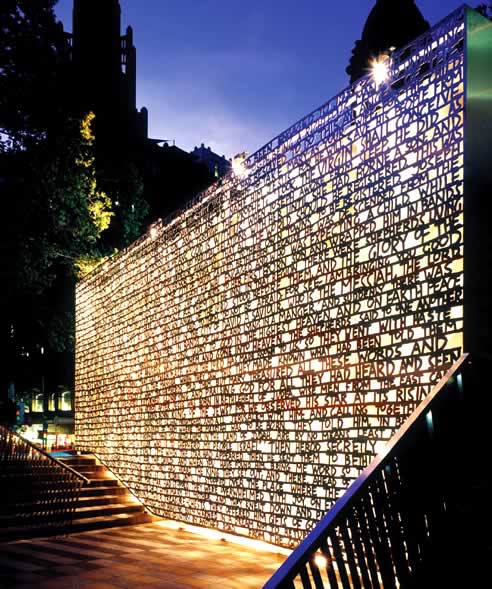Tuesday, February 15, 2011
Materials in Architecture
Connections:
Every structure is made of distinct parts. Where these parts connect with one another, it is important to pay special attention how they connect, both visually and mechanically.  Make the connection between parts clearly visible, so that people can appreciate and enjoy how the structure is held together. For example in this Japanese garden bridge, horizontal and vertical members are connected with a clearly visible mortise and tenon joint that is held in place by a clearly visible wooden peg. This interpenetration of forms makes for a more intimate bond between the parts.
Make the connection between parts clearly visible, so that people can appreciate and enjoy how the structure is held together. For example in this Japanese garden bridge, horizontal and vertical members are connected with a clearly visible mortise and tenon joint that is held in place by a clearly visible wooden peg. This interpenetration of forms makes for a more intimate bond between the parts.Attention to connection between parts is particularly important when one material meets another. A sharp, distinct and uncluttered connection emphasizes and clarifies the differences in the materials.
Effect of Light on Materials:
 Light and shadow can have a profound effect on how we perceive materials. The direction and type of light affects how a material's surface texture appears. The color of light effects how colors appear.
Light and shadow can have a profound effect on how we perceive materials. The direction and type of light affects how a material's surface texture appears. The color of light effects how colors appear. When choosing materials and colors, consider how they will appear under the different lighting conditions in which they will be seen, including time of day, amount of cloud cover, and both natural and artificial lighting.
 |
| Perched on a hilltop, this chapel is a fantastic study of architecture as sculpture. The concrete walls are prow-like and the roof resembles an inverted crab shell. Le Corbusier wrote of the chapel, "the key is the light, and the light clarifies the forms." Criticized as a shocking piece of irreverence by the disciples of strict modernism, the chapel was a highly personal work for Le Corbuiser that allowed for emotion, rather than banishing it. Gentle light descends onto three altars from hidden skylights. |
Express Purpose Through Materials:
Use materials to define forms and distinguish between different objects / structures. Honesty of Materials:
Use materials that really are what they appear to be. Do not use imitation materials that attempt to look like something they are not. Avoid painting materials to hide their true nature, but instead celebrate the imperfections of the material.Instead, choose materials that are best suited for what you are using them for.

Material Associations:
People often have associations with specific materials. These associations may be positive, negative or neutral.
For example:
For example:
- Raw concrete may be associated with neglected, run-down buildings.
- Terrazzo may be associated with schools, hospitals or other institutional buildings.
When choosing a material, consider that not only the materials innate qualities, but also people's associations with the material, will have a strong impact on how it is perceived.
Natural Materials:
We are very attracted to materials that have fine detail, variation and that tell a story of where they come from.
Natural materials often feel more "alive", more pleasant, than many manufatured materials. They often have more variation on a single surfaces, and between one piece of the material and another. Several pieces from a single species of Wood, for instance, may very subly in color, grain uniformity, and grain size.
 |
| Although concrete and metal are certainly manufactured materials, here their true nature is expressed, giving them a very natural feeling. |
Texture:
Texture is central to our experience of different materials.
When choosing and contrasting materials, consider the texture of its surface. In particular, consider:
Having a surface high in texture can add interest and contrast.
Too much texture psychologically eats into personal space.
Smooth textures can attract, while rough and hard can repel.
Consider use of both delicate and strong textures.

Contrasting Materials:
The unique qualities of each material are most obvious when used next to or in conjunction with other materials with contrasting characteristics.
When selecting contrasting materials, consider the color, shininess, roughness, variation vs. uniformity of the materials, and select materials that are significantly different in at least one of these qualities.

Architectural Design Process

Programming Phase:
Programming is the activity of determining the "program", or set of needs that a building needs to fulfill.
Problem / Situation:
In order for a design to succeed, in must be rooted in a thorough understanding of the user's needs, the constraints and other goals of the project.
While many requirements in the program are often stipulated at the outset by the client, many needs and constraints may not be immediately obvious. Without a thorough up-front exploration of the program, a significant need or constraint may not be discovered until later in the project, when it will be much more expensive and time-consuming to address.
A less obvious, but equally important failure is not recognizing more subtle needs - things that may be ignored by everyone throughout the project, and may never be realized. It is attention to these more subtle needs throughout the design process that makes the difference between an okay building and a great building.
While many requirements in the program are often stipulated at the outset by the client, many needs and constraints may not be immediately obvious. Without a thorough up-front exploration of the program, a significant need or constraint may not be discovered until later in the project, when it will be much more expensive and time-consuming to address.
A less obvious, but equally important failure is not recognizing more subtle needs - things that may be ignored by everyone throughout the project, and may never be realized. It is attention to these more subtle needs throughout the design process that makes the difference between an okay building and a great building.
Solution:
Any project should begin with a thorough examination of these needs, goals and constraints, to form as complete as possible an understanding of these issues.
This includes an examination of who the users of the building will be, what use they will make of the building, what rooms/spaces they need, what mood the building should create, and any other goals of the project.
It also includes an examination of constraints, such as cost, zoning and building code restrictions, and locally available materials.
During the programming phase, it is normal to identify what rooms/spaces are needed. For each space, consider at least the following requirements:
It is also important to gain a thorough understanding of the site at this stage; to get a deep understanding of the character or "genre" of the site.
This includes an examination of who the users of the building will be, what use they will make of the building, what rooms/spaces they need, what mood the building should create, and any other goals of the project.
It also includes an examination of constraints, such as cost, zoning and building code restrictions, and locally available materials.
During the programming phase, it is normal to identify what rooms/spaces are needed. For each space, consider at least the following requirements:
- Who will use the space
- Use(s) of the space; what activities will take place there
- How private or public should the space be
- Which other spaces should be adjacent or most accessible from that space
- What type of mood should the space create
- How large should the space be
It is also important to gain a thorough understanding of the site at this stage; to get a deep understanding of the character or "genre" of the site.
Schematic Design Phase:
After establishing the program for a project, the focus in the architectural design process shifts from what the problems are to how to solve those problems. During schematic design, the focus is on the "scheme", or overall high-level design. Here, minor details should be ignored to instead focus on creating a coherent solution that encompasis the project as a whole.
Solution:
A major focus of this phase is the relationship between rooms and spaces. Consider which spaces should be adjacent to one another and gradients of public vs private spaces when sketching out the layout of spaces.
Design Development Phase:
During the design development phase of the architectural design process, the scheme is refined into the final design. In previous phases, the focus has been on the project as a whole. During Design Development, in becomes important to give individual attention to each aspect, each space and each detail of the project.
Construction Document Phase:
At this stage of the architectural design process, the focus shifts from design to communicating the design and providing all information necessary for construction.
Architectural Design Principles
Additive vs Subtractive:
Space and form can be perceived as an additive or subtractive composition.
An additive composition is one in which pieces appear to have been combined together to create the whole, much like pieces of clay added on to one another.
A subtractive composition is one in which bits appear to have been chipped away from a monolithic block, much like a sculptor chips away pieces until the final sculpture is visible. The eye fills in missing parts to see a whole solid as the unity of composition.

Contrast:
Our perception is relative. That is, we often perceive things in how they contrast or differ from other things. Sometimes we perceive them as similar or the same. Human perception tends to compare and contrast, thus if we are mindful of the mechanisms of perception, design could be used to steer or influence (but not control) perceptions.
Create contrasts in materials, sizes of adjacent spaces, proportions of details, to make those details stand out.
In particular, use contrast in places where you need to get attention - such as directing people's attention to the entry of a building.
Examples of contrasts include: round vs square, tall vs short, dark vsslight, hard vs soft, smooth vs rough, cocave vs convex, many vs few, simple vs complex.
In particular, use contrast in places where you need to get attention - such as directing people's attention to the entry of a building.
Examples of contrasts include: round vs square, tall vs short, dark vsslight, hard vs soft, smooth vs rough, cocave vs convex, many vs few, simple vs complex.
Perception:
When designing a building, structure or other built environment, consider the ways in which it can be perceived:
- By senses - not just sight, but sound, temperature, touch, even smell
- By reason and intellect
- By emotions - excitement, comfort, etc.
Architectural Concepts - Space
Depending on its size and shape, space can feel comfortably enclosing, depressingly shut in, liberatingly spacious, or so large that one feels lost in its vastness. It is important to bear in mind that different people with different personal bubbles will experience the same space differently.
Dynamic Flow of Spaces:
The most compelling spaces are often not static, individual spaces unto themselves, but part of a larger series of spaces. This pattern and its supporting patterns are about ways of creating spaces that flow into one another and invite you to explore and experience the set of spaces. Your goal should be to have a series of spaces reveal themselves self gradually in an experience that contains both order and mystery.
While it is important to have more static spaces where one feels perfectly comfortable to remain still, it is also important to have places where one is invited to move further.
When planning people's movement through space, orchestrate it so each space sets one up for the effect of next one. The movement through space can be rapidily flowing to a visible outcome, or many stepped with detours and events along the way.
Rooms need not be single units unto themselves. Intead, spaces can be layered such as an atrium, loft, or other enclosures within a larger space.
When thinking of the flow through spaces, begin by examining the experience of arriving on the site. Then, proceed on to the experience of entering and finally moving through the building.
Give Circulation Spaces Equal Importance:

All too often, circulation spaces such as hallways and stairs are carved out of leftover spaces, and no particular attention is paid to making them anything more than a way to get from point A to point B. People's experience of a building will be greatly enhanced if circulation spaces are given equal importance to other spaces.
Encourage people to linger and enjoy these circulation spaces.
One way to accomplish this is to give circulation spaces additional uses. Include seating, display of artwork, or views to the world beyond.

Layering Spaces:
Layer spaces one after another so that one can see inviting layers beyond the immediate space being occupied.

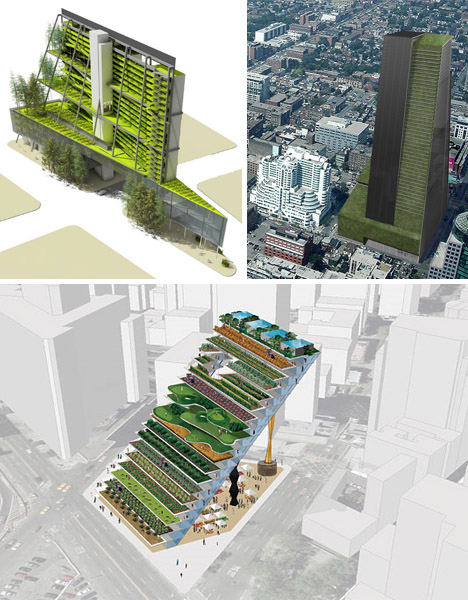
Long Slender Spaces:
A long slender space suggests a feeling of movement, encouraging one to pass through to the next space beyond.


 Create one axis that starts at the entrance, branching towards light and views and away from noise.
Create one axis that starts at the entrance, branching towards light and views and away from noise.
Create another axis that starts from the ground and moves towards the sky.
These axis could be defined by a circulation path, roof ridge, etc.


Dynamic Flow of Spaces:
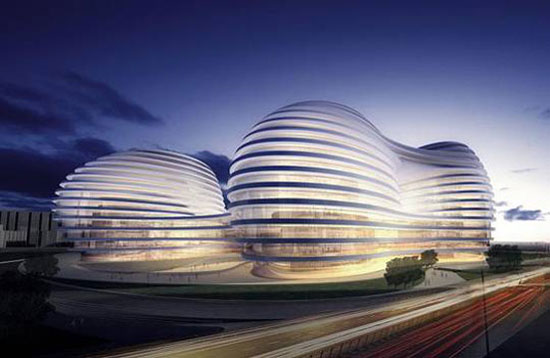 |
| Zaha Hadid: Chaoyangmen SOHO III |
The most compelling spaces are often not static, individual spaces unto themselves, but part of a larger series of spaces. This pattern and its supporting patterns are about ways of creating spaces that flow into one another and invite you to explore and experience the set of spaces. Your goal should be to have a series of spaces reveal themselves self gradually in an experience that contains both order and mystery.
While it is important to have more static spaces where one feels perfectly comfortable to remain still, it is also important to have places where one is invited to move further.
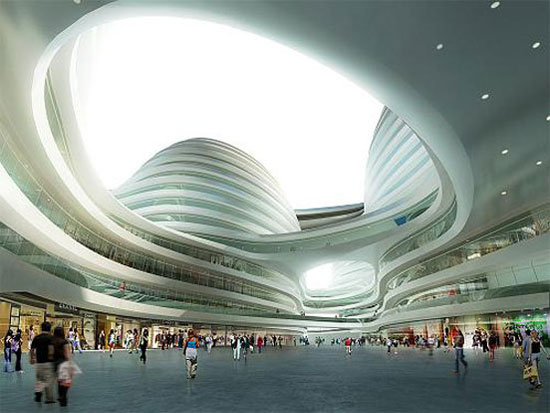 |
| Inner Courtyard |
When planning people's movement through space, orchestrate it so each space sets one up for the effect of next one. The movement through space can be rapidily flowing to a visible outcome, or many stepped with detours and events along the way.
Rooms need not be single units unto themselves. Intead, spaces can be layered such as an atrium, loft, or other enclosures within a larger space.
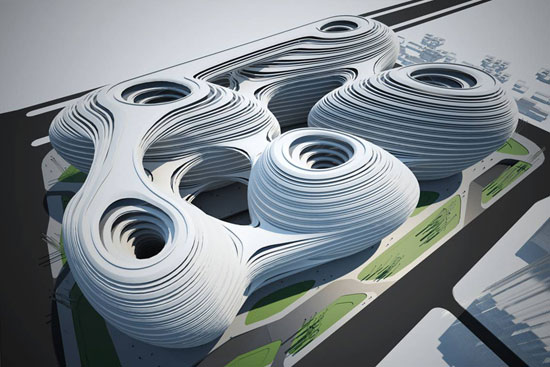 |
| Interconnected Flow of Spaces Circulation at Edges: Place circulation routes at the edge of larger communal or public spaces. You should aim to bring life to the shared spaces by connecting them to the comings and goings of people in the building / house, while not disturbing the activities in these public spaces. To direct people to use these circulation routes, make them distinct by providing different floor level, different flooring material, half walls, columns, etc. Stairs should be located to leave the main circulation route on one floor and connect to the main circulation route on another floor. |
When thinking of the flow through spaces, begin by examining the experience of arriving on the site. Then, proceed on to the experience of entering and finally moving through the building.
Give Circulation Spaces Equal Importance:

All too often, circulation spaces such as hallways and stairs are carved out of leftover spaces, and no particular attention is paid to making them anything more than a way to get from point A to point B. People's experience of a building will be greatly enhanced if circulation spaces are given equal importance to other spaces.
Encourage people to linger and enjoy these circulation spaces.
One way to accomplish this is to give circulation spaces additional uses. Include seating, display of artwork, or views to the world beyond.

Layering Spaces:
Layer spaces one after another so that one can see inviting layers beyond the immediate space being occupied.


Long Slender Spaces:
A long slender space suggests a feeling of movement, encouraging one to pass through to the next space beyond.

Multiple Directions:
Give multiple options for the direction one can take from any given space.
Open Plan:
Use of open plans ("open concept designs") where several spaces are created out of one larger space permits a more dynamic flow between these spaces that dividing the same overall space into several smaller rooms.
Furthermore, by allowing multiple spaces to overlap and share their space with one another, a greater feeling of expanse can be created within a smaller amount of floor space.
Furthermore, by allowing multiple spaces to overlap and share their space with one another, a greater feeling of expanse can be created within a smaller amount of floor space.

Organize Spaces Along Axes of Movement:
 Create one axis that starts at the entrance, branching towards light and views and away from noise.
Create one axis that starts at the entrance, branching towards light and views and away from noise.Create another axis that starts from the ground and moves towards the sky.
These axis could be defined by a circulation path, roof ridge, etc.
Transitions:
When consider flow and movement from one space to another, give particular attention to the place where one transitions from being in one space to being in the next.
Offer a moment's pause at each transition, by providing something interesting. For the most important transitions from one space to another, mark the transition with something particularly signficant.
Offer a moment's pause at each transition, by providing something interesting. For the most important transitions from one space to another, mark the transition with something particularly signficant.

Transparency:
By creating partially or entirely transparent boundaries between spaces, such as by exterior windows or interior glass partitions, a very dynamic interconnection between the spaces can be created, while still separating the spaces from one another.

Subscribe to:
Posts (Atom)







